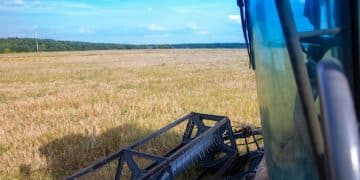US Farm Debt Trends: Factors Behind the Recent Increase

US Farm Debt Trends: Understanding the Factors Contributing to the Recent Increase involves analyzing the escalating debt levels among American farmers due to factors like low commodity prices, trade disputes, adverse weather conditions, and fluctuating interest rates, impacting farm profitability and financial stability.
The agricultural landscape in the United States is facing a growing challenge as US Farm Debt Trends: Understanding the Factors Contributing to the Recent Increase becomes increasingly crucial for farmers and policymakers alike. Let’s delve into the factors shaping this trend.
Understanding the Current State of US Farm Debt
US farm debt has seen notable shifts in recent years, influenced by a variety of economic and environmental factors. Comprehending the current scenario is paramount for stakeholders aiming to navigate the financial complexities of the agricultural sector.
Key Indicators of Farm Debt
Several metrics offer insights into the health of farm finances. These include:
- Outstanding Loan Balances: Tracking the total amount of credit farmers owe to lenders.
- Debt-to-Asset Ratios: Comparing a farm’s liabilities to its assets to assess solvency.
- Interest Rates: Monitoring the cost of borrowing money, which impacts debt servicing.
Recent Trends in Farm Lending
Recent data indicates an upward trajectory in farm debt. This is attributed to various reasons, including:
- Decreased Farm Income: Lower commodity prices combined with increased input costs squeeze profit margins.
- Investment in Technology: Modern farming practices often require significant capital expenditure.
- Land Acquisition: Farmers may take on debt to expand their operations or invest in real estate.

In summary, evaluating key indicators and understanding the forces behind farm lending trends are essential for grasping the magnitude of the challenges facing American farmers today.
The Role of Commodity Prices
Commodity prices play a pivotal role in the financial health of farming operations. Fluctuations in these prices can directly affect a farmer’s ability to manage debt.
Impact of Low Commodity Prices
When commodity prices are low, farmers receive less revenue for their produce. This can lead to:
- Reduced Cash Flow: Making it difficult to cover operating expenses and debt payments.
- Inventory Build-Up: Storing unsold crops, which incurs additional costs.
- Increased Borrowing: Relying on credit to stay afloat during periods of low profitability.
Global Market Influences
Global events and trade policies can significantly impact commodity markets. Factors like:
- Trade Disputes: Disrupting international trade routes and reducing export opportunities.
- Currency Fluctuations: Affecting the competitiveness of US agricultural products.
- Geopolitical Instability: Creating uncertainty in the demand for and supply of commodities.
In conclusion, monitoring commodity prices and understanding how global factors influence agricultural markets are crucial for farmers attempting to navigate the challenges of farm debt.
Impact of Trade Disputes on Farm Finances
Trade disputes have had complex effects on the agricultural sector, contributing to financial strain and increasing debt levels for many farmers.
Effects of Tariffs on Exports
The imposition of tariffs by trading partners has directly affected agricultural exports. This has led to:
- Reduced Export Volumes: Lower demand for US farm products in key markets.
- Price Reductions: Lower prices to compete in markets with fewer trade barriers.
- Government Subsidies: Increased reliance on government support to offset losses.
Ripple Effects on Local Economies
The impact of trade disputes extends beyond individual farms, affecting entire rural communities. This includes:
- Reduced Investments: Lower profitability discourages investments in farm infrastructure.
- Job Losses: Decreased economic activity in agricultural supply chains.
- Community Stress: Increased financial strain on rural families and businesses.

To summarize, trade disputes have created a challenging environment for US farmers, impacting exports, local economies, and contributing to increasing levels of farm debt.
The Influence of Weather Conditions
Adverse weather conditions present a significant challenge to agricultural production, leading to reduced yields, increased costs, and greater financial vulnerability for farmers.
Extreme Weather Events
The increasing frequency and severity of extreme weather events, such as droughts, floods, and hurricanes, can have devastating consequences for farm finances. These include:
- Crop Losses: Reduced yields due to insufficient or excessive rainfall.
- Livestock Losses: Impacting meat and dairy production, leading to economic setbacks.
- Infrastructure Damage: High costs associated with repairing damaged properties.
Long-Term Climate Trends
Shifting climate patterns can alter growing seasons and affect overall productivity. This creates long-term challenges, such as:
- Changes in Planting Zones: Forcing farmers to adapt to new crop varieties and management practices.
- Water Scarcity: Increasing competition for water resources, leading to higher irrigation costs.
- Soil Degradation: Loss of soil fertility, affecting long-term productivity.
In conclusion, adverse weather conditions and changing climate trends pose ongoing challenges for farmers, contributing to financial instability and increasing the need for debt financing.
Interest Rates and Debt Servicing Costs
Interest rates have a crucial role in determining the affordability of farm debt. Fluctuations in interest rates can significantly affect debt servicing costs and overall farm profitability.
Impact of Rising Interest Rates
Rising interest rates directly impact the cost of borrowing, making it more expensive for farmers to finance operations. This frequently leads to:
- Higher Debt Payments: Reducing available cash flow for other essential expenses.
- Reduced Investment: Limiting the ability to invest in technology and infrastructure.
- Increased Financial Stress: Making it difficult to manage debt and maintain profitability.
Managing Interest Rate Risk
Farmers can employ various strategies to mitigate the risk associated with interest rate fluctuations. These strategies may include:
- Fixed-Rate Loans: Locking in a specific interest rate for the duration of the loan.
- Interest Rate Swaps: Exchanging variable interest rate payments for fixed payments.
- Debt Consolidation: Combining multiple loans into a single loan with more favorable terms.
In summary, understanding the impact of interest rates on debt servicing costs and implementing strategies to manage interest rate risk are essential for maintaining financial stability in a changing economic environment.
Strategies for Farmers to Manage Debt
Effectively managing debt is crucial for sustaining the financial health of farming operations. Farmers can utilize a range of strategies to navigate their financial challenges and reduce debt burdens.
Financial Planning and Budgeting
Comprehensive financial planning is foundational for effective debt management and farmers can achieve it by:
- Creating a Budget: Tracking income and expenses to identify areas for cost reduction.
- Setting Financial Goals: Establishing clear targets for debt reduction and profitability.
- Regular Monitoring: Assessing financial performance and adjusting strategies as needed.
Diversification and Innovation
Diversification can create new revenue streams, while innovation can increase efficiency and reduce costs. Some approaches are:
- Crop Diversification: Growing a variety of crops to reduce risk associated with commodity price fluctuations.
- Value-Added Products: Processing and marketing agricultural products to increase revenue potential.
- Technological Adoption: Utilizing precision farming techniques, data analytics, and automation to improve productivity.
Overall, proactive financial planning and embracing diversified and innovative practices can significantly enhance farmers’ ability to manage debt effectively and secure their financial future.
| Key Topic | Brief Description |
|---|---|
| 📉 Farm Debt Increase | Factors like low commodity prices and trade issues are driving farm debt. |
| 🌍 Global Trade | Trade disputes reduce export markets, impacting farmer incomes. |
| 🌦️ Weather Impact | Extreme weather events cause crop losses and financial strain. |
| 💡 Debt Strategies | Financial planning and diversification can aid debt management. |
Frequently Asked Questions (FAQ)
▼
US farm debt is increasing due to a combination of factors, including low commodity prices, trade disputes, and adverse weather conditions. These elements reduce farm income, compelling farmers to borrow more to sustain operations.
▼
Trade disputes reduce export opportunities for US farmers, resulting in lower revenue. Consequently, farmers may need to borrow more money to cover their operating costs and manage their existing debt obligations.
▼
Extreme weather events such as droughts and floods can lead to significant crop and livestock losses, directly decreasing farm income. Farmers often need to take on additional debt to recover from these losses and continue farming.
▼
Farmers can employ several strategies to manage debt, including detailed financial planning, diversification of crops, and the adoption of innovative technologies to improve efficiency and reduce costs. Also, seeking financial advice can be valuable.
▼
Higher interest rates increase the cost of borrowing, making it more expensive for farmers to finance their operations. Managing interest rate risk through strategies like fixed-rate loans can help stabilize financial planning and reduce debt burdens.
Conclusion
Understanding the complexities of US Farm Debt Trends: Understanding the Factors Contributing to the Recent Increase is vital for farmers, policymakers, and stakeholders in the agricultural sector. By addressing the underlying causes and adopting effective management strategies, the agricultural community can work towards achieving greater financial stability and resilience.





